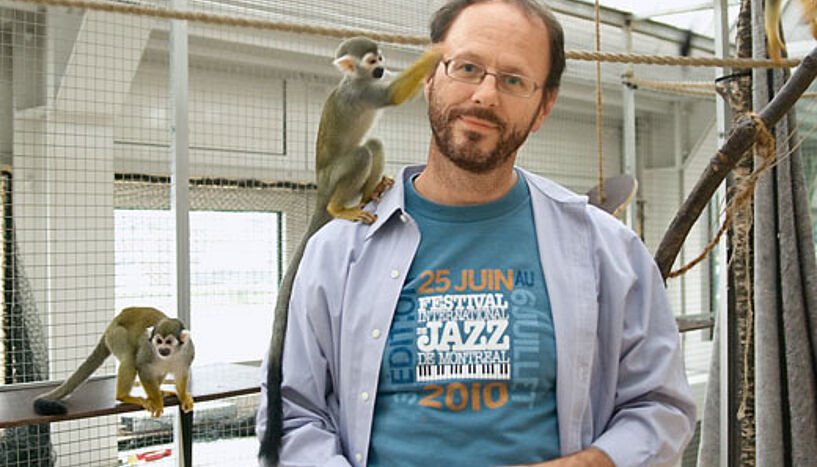Monkey Lip Smacks Provide New Insights Into the Evolution of Human Speech
31. Mai 2012
Tecumseh Fitch, Head of the Department of Cognitive Biology, with Saimiri (Copyright: University of Vienna).
Scientists have traditionally sought the evolutionary origins of human speech in primate vocalizations, such as monkey coos or chimpanzee hoots. But unlike these primate calls, human speech is produced using rapid, controlled movements of the tongue, lips and jaw. Speech is also learned, while primate vocalizations are mostly innately structured. New research published in "Current Biology" by W. Tecumseh Fitch, Head of the Department of Cognitive Biology at the University of Vienna, supports the idea that human speech evolved less from vocalizations than from communicative facial gestures.
Researchers at Princeton and the University of Vienna used x-ray movies to investigate lip-smacking gestures in macaque monkeys. Lip smacks are made by many monkey species in friendly, face-to-face situations (e.g. between mothers and their infants). Although lip-smacking makes a quiet sound (similar to "p p p p"), it is not accompanied by phonation, which is produced by vocal cord vibration in the "voice box" or larynx.
Although superficially lip-smacking appears to involve simply rapid opening and closing of the lips, the x-ray movies show that lip-smacking is actually a complex behaviour, requiring rapid, coordinated movements of the lips, jaw, tongue and the hyoid bone (which provides the supporting skeleton for the larynx and tongue). Furthermore these movements occur at a rate of about 5 cycles per second, the same as speech, and are much faster than chewing movements (about 2.5 cycles per second). Thus, although lip smacking superficially resembles "fake chewing", it is in fact very different, and more like speech.
Fascinating facial signals
These observations support a long-standing hypothesis of Peter MacNeilage and his colleagues that the roots of human speech do not lie in primate vocalizations, but are closer to these fascinating facial signals used for communication by monkeys. In particular, the alternation between vowel and consonant that generates speech syllables is strikingly similar to the movements underlying lip-smacking.
Intriguingly, chimpanzees also make communicative sounds with their lips, including both loud lip smacks and lip buzzes ("raspberries"). These lip gestures appear to be under voluntary control, and can be learned (unlike hoots or grunts). Similarly, orangutans can learn to whistle: again a sound produced using the lips and tongue, rather than the larynx.
Together, these data from our primate cousins support the idea that the origins of speech might be found in an evolutionary combination of "traditional" phonation (sounds produced by the vocal cords, in the larynx) with rapid, learned movements of the vocal tract, which have stronger similarities to primate facial signals than to their innate calls. But the origin of the "singing" component of speech, which requires voluntary control over the larynx, remains mysterious.
Publication in "Current Biology":
Cineradiography of Monkey Lip-smacking Reveals Putative Precursors of Speech Dynamics: Asif A. Ghanzanfar, Daniel Y. Takahashi, Neil Mathur and W. Tecumseh Fitch.
Current Biology, July 10, 2012 print issue. DOI: 10.1016/
Scientific contact
Prof. W. Tecumseh Fitch
Department of Cognitive Biology
University of Vienna
1090 Vienna, Althanstraße 14
T +43-1-4277-761 01
tecumseh.fitch(at)univie.ac.at
Wissenschaftlicher Kontakt
Univ.-Prof. W. Tecumseh Fitch
Department für KognitionsbiologieUniversität Wien
1090 - Vienna, Althanstraße 14
+43-1-4277-761 11
tecumseh.fitch@univie.ac.at
Downloads:
Fitch_Totenkopfaffen_Saimiri_03.jpg
Dateigröße: 1,98 MB
